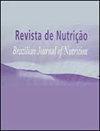超加工食品对幼儿学校供餐营养膳食的贡献
IF 0.5
4区 医学
Q4 NUTRITION & DIETETICS
Revista De Nutricao-brazilian Journal of Nutrition
Pub Date : 2022-01-01
DOI:10.1590/1678-9865202235e210106
引用次数: 1
摘要
摘要目的探讨超加工食品对公立日托中心学校供餐营养膳食结构的影响。方法横断面研究于2013年6月- 11月进行。在非连续的20天内收集6份日常膳食样本。总共为12-36个月大的孩子提供117份学校餐(123种食物)。所提供的份量由直接加权决定。理化分析确定其营养成分。学校膳食按照加工程度分类:(A)未加工/最低加工/烹饪准备,(B)加工食品,或(C)超加工食品。计算各组对能量、常量营养素和钠的贡献。组间比较采用学生t检验。结果超加工食品提供了45.8%的能量、33.9%的脂质、42.8%的蛋白质、48.9%的碳水化合物和20.9%的钠。所有午餐和90%的晚餐被归类为未加工/最低加工/烹饪准备。39.0%的膳食是超加工的(主要是早餐和零食)。超加工食品每份含有更多的能量(p=0.026)和碳水化合物(p<0.001),而未加工/最低加工/烹饪准备每份含有更多的钠(p<0.001)。尽管大多数膳食被归类为未加工/最低加工/烹饪准备,但在生命的这个阶段应该避免的超加工食品每天都提供,每份提供更高的能量和碳水化合物。市政当局需要根据2021年生效的第6/2020号新决议,改善向这些儿童日托中心儿童提供的膳食质量。本文章由计算机程序翻译,如有差异,请以英文原文为准。
Contribution of ultra-processed food to the nutritional dietary profile of young children school feeding
ABSTRACT Objective To investigate the contribution of ultra-processed food to the nutritional dietary profile of school feeding in public child day-care centers. Methods Cross-sectional study carried out from June-November/2013. Samples from six daily meals were collected in twenty non-consecutive days. A total of 117 school meals (123 food items) were offered to children from 12-36 months of age. The served portions were determined by direct weighting. Physicochemical analyses were performed to establish the nutritional composition. School meals were classified according to the processing degree: (A) unprocessed/minimally processed/culinary preparations, (B) processed food, or (C) ultra-processed food. The contribution of each group to the quantity of energy, macronutrients and sodium was calculated. Student’s t test was applied for comparison between groups. Results Ultra-processed meals contributed to 45.8% of energy, 33.9% of lipids, 42.8% of proteins, 48.9% of carbohydrates, and 20.9% of sodium. All lunches and 90% of dinners were classified as unprocessed/minimally processed/culinary preparations. 39.0% of the meals were ultra-processed (mainly breakfast and snacks). Ultra-processed meals had a greater quantity of energy (p=0.026) and carbohydrates (p<0.001) per serving, while unprocessed/minimally processed/culinary preparations offered more sodium per serving (p<0.001). Conclusion Although most meals were classified as unprocessed/minimally processed/culinary preparations, ultra-processed food, which should be avoided at this stage of life, are offered daily, contributing with higher energy and carbohydrates offer per serving. The municipality need to improve the quality of the meals offered to children in these child day-care centers, observing the new Resolution nº 6/2020 that came into effect in 2021.
求助全文
通过发布文献求助,成功后即可免费获取论文全文。
去求助
来源期刊
CiteScore
1.20
自引率
12.50%
发文量
24
审稿时长
6-12 weeks
期刊介绍:
Revista de Nutrição is former Revista de Nutrição da Puccamp, founded in 1988. It is a bimonthly publication every four months and it is of responsibility of the Centro de Ciências da Vida, da Pontifícia Universidade Católica de Campinas . It publishes articles that contribute to the study of Nutrition in its many sub-areas and interfaces; and is open to contributions of the national and international scientific communities.

 求助内容:
求助内容: 应助结果提醒方式:
应助结果提醒方式:


